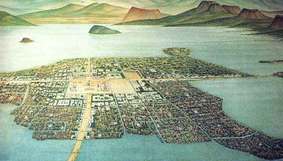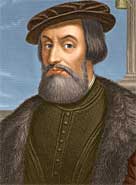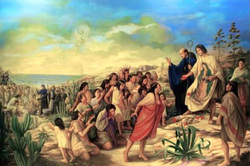The Aztecs

The Aztecs ruled most of Central American in 1500. Their Empire was known as Mesoamerica and extended from the Gulf of Mexico to the Pacific Ocean. It included Mexico, Guatemala and Belize. In 1503, Montezuma (Moctezuma) the Younger became King of the Aztecs. He ruled from the capital Tenochtitlan and it’s sister-city Tlatelolco, site of modern day Mexico City. The capital was the center of religious worship for the Aztecs. The people of Mexica believed that the gods required human blood for sacrifice. The priests sacrificed thousands of living humans from surrounding tribes to appease the deities. Generally, the human sacrifices were members from surrounding tribes.
The god Quetzalcoatl, the feathered serpent, founded the Aztec nation. He strongly opposed the terrible tradition of human sacrifice and left when it began. He vowed to return one day to reclaim his throne and redeem Aztecs. Quetzalcoatl said he would return in Year 1-Reed, which occurred every 52 years in Aztec time cycle.
In 1509, Princess Papantzin, Montezuma’s sister lapsed into a coma. When she recovered she shared a dream that influenced the King. In her dream a being with a black cross on his forehead led her to a shore with large ships that would come conquer the Aztecs and bring them the true God. Years later, in year 1-Reed, the Conquistadors of Spain arrived on the shores of Mexico.
The god Quetzalcoatl, the feathered serpent, founded the Aztec nation. He strongly opposed the terrible tradition of human sacrifice and left when it began. He vowed to return one day to reclaim his throne and redeem Aztecs. Quetzalcoatl said he would return in Year 1-Reed, which occurred every 52 years in Aztec time cycle.
In 1509, Princess Papantzin, Montezuma’s sister lapsed into a coma. When she recovered she shared a dream that influenced the King. In her dream a being with a black cross on his forehead led her to a shore with large ships that would come conquer the Aztecs and bring them the true God. Years later, in year 1-Reed, the Conquistadors of Spain arrived on the shores of Mexico.
Hernando Cortes and the Conquistadors

The Spaniard Hernando Cortes (Cortez) landed on the Gulf Shore of Mexico on Good Friday, April 22, 1519. Expedition recordings indicate that Cortes arrived with 508 soldiers on eleven ships, 100 sailors, 16 horses, a few cannons, crossbows and other artillery. They named the landing site Veracruz “The True Cross.” Cortes sent one ship back to Spain with a detailed letter for King Charles V. He burned the last ten ships, cutting off any retreat plans and showing deep commitment to his conquest. The arrival of Cortes’ forces frightened the Indians. Cortes, with the help of Indian interpreter Dona Marina, won over outlying Indian tribes, many who resented the Aztecs. The strongest alliance Cortes formed was with the Tlaxcalans.
Along their expedition, Cortes and his forces found evidence of human sacrifice and were determined to stop the horrific practice. Montezuma, King of the Aztecs, planned a trap for Cortes but his forces and his allies overwhelmed the King’s men and left 3000 dead. Recalling his sister’s dream, Montezuma felt that Cortes was the returning god Quetzalcoatl and welcomed Cortes into the capital city on November 8, 1519. Montezuma continued human sacrifice against Cortes’ protests. As a result, Cortes placed Montezuma under house arrest. However, human sacrifice continued. Cortes, finally, climbed the stairs of the main Aztec temple and removed the gods and replaced them with a Cross and image of the Blessed Virgin Mary. The Aztec rituals stopped for three months.
Soon after, Cortes let the city for political reasons. He left Pedro de Alvarado in charge. In the spring of 1520, during the festival of the sun god Huitzilopchtli, Alvarado surrounded the Aztec temples and slaughtered the unarmed celebrants. The people of Mexica rose up and attacked the Spaniards. Montezuma died in the battle. Cortes returned to find the city in warfare. The Spaniards were defeated and driven from the city on June 30 1520, the Night of Sorrow.
Cortes returned to Tenochtitlan in May of 1521 with a massive army of Indians, mostly Tlaxcalans. They were surprised to find half of the population had died of a smallpox epidemic, including King Cuitlahauc. The new leader, Cuauhtemoc, fought Cortes and his army for 93 days. On August 13, 1521 the city was surrendered to Cortes. The city was destroyed and so was the Aztec practice of human sacrifice. The conquest of Mesoamerica was complete.
Along their expedition, Cortes and his forces found evidence of human sacrifice and were determined to stop the horrific practice. Montezuma, King of the Aztecs, planned a trap for Cortes but his forces and his allies overwhelmed the King’s men and left 3000 dead. Recalling his sister’s dream, Montezuma felt that Cortes was the returning god Quetzalcoatl and welcomed Cortes into the capital city on November 8, 1519. Montezuma continued human sacrifice against Cortes’ protests. As a result, Cortes placed Montezuma under house arrest. However, human sacrifice continued. Cortes, finally, climbed the stairs of the main Aztec temple and removed the gods and replaced them with a Cross and image of the Blessed Virgin Mary. The Aztec rituals stopped for three months.
Soon after, Cortes let the city for political reasons. He left Pedro de Alvarado in charge. In the spring of 1520, during the festival of the sun god Huitzilopchtli, Alvarado surrounded the Aztec temples and slaughtered the unarmed celebrants. The people of Mexica rose up and attacked the Spaniards. Montezuma died in the battle. Cortes returned to find the city in warfare. The Spaniards were defeated and driven from the city on June 30 1520, the Night of Sorrow.
Cortes returned to Tenochtitlan in May of 1521 with a massive army of Indians, mostly Tlaxcalans. They were surprised to find half of the population had died of a smallpox epidemic, including King Cuitlahauc. The new leader, Cuauhtemoc, fought Cortes and his army for 93 days. On August 13, 1521 the city was surrendered to Cortes. The city was destroyed and so was the Aztec practice of human sacrifice. The conquest of Mesoamerica was complete.
The Church in New Spain

Cortes placed the region under the Spanish crown and demolished the temples of sacrifice and built Catholic churches in their place. The Church Santiago de Tlatelolco was build on the site of the Temple of the sun god in present-day Mexico City. Cortes called for missionaries to convert the natives. Franciscan Peter Ghent, Fray Pedro de Gante, from Belgium learned the ways of the natives and began to educate them with the Christian message.
In August of 1524, twelve Franciscan missionaries arrived. They found the natives resistant to Christianity, the religion the people who had killed thousands of Indians, raped their women, and destroyed Tenochtitlan.
Nearly a decade after Spain’s conquest of Mexico, the future of Christianity on the American continent was in doubt. Officials sent to the New Word in the following years. Their treatment of the native population was damaging to their relationship. The Indians became fed up with Spanish occupation. High tensions resulted in outbreaks of fights. The bishop-elect of Mexico wrote to the King of Spain to tell him that unless there was a miracle, the continent would be lost. This was the setting when the evens of Our Lady of Guadalupe occurred.
In August of 1524, twelve Franciscan missionaries arrived. They found the natives resistant to Christianity, the religion the people who had killed thousands of Indians, raped their women, and destroyed Tenochtitlan.
Nearly a decade after Spain’s conquest of Mexico, the future of Christianity on the American continent was in doubt. Officials sent to the New Word in the following years. Their treatment of the native population was damaging to their relationship. The Indians became fed up with Spanish occupation. High tensions resulted in outbreaks of fights. The bishop-elect of Mexico wrote to the King of Spain to tell him that unless there was a miracle, the continent would be lost. This was the setting when the evens of Our Lady of Guadalupe occurred.
